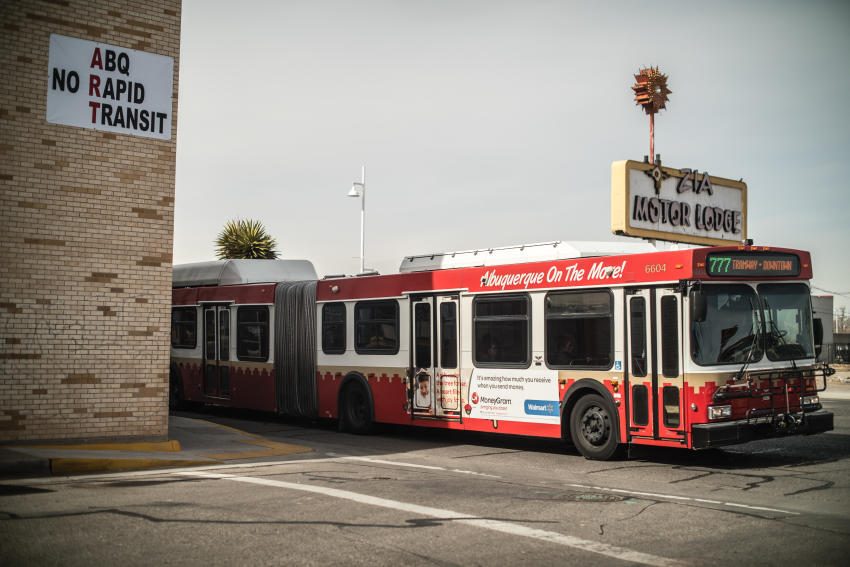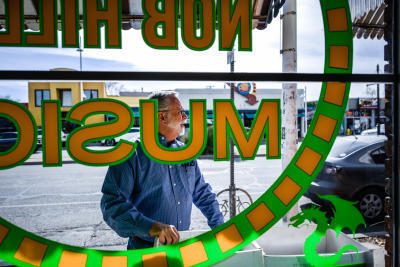
Albuquerque Rapid Transit
Supporters say
⋄ It has the benefits of light rail at a fraction of the price and will boost economic development.
⋄ Major employers and cultural destinations lie along the route, making it easier for people to get there without owning a car.
⋄ Even with reduced traffic capacity, Central Avenue will continue to operate at an acceptable level and nearby streets have the capacity to handle increased traffic, according to a city-commissioned traffic study.
⋄ The city will work with businesses along Central to minimize the disruption caused by construction.
⋄ Sidewalks will be widened where there’s room available, they will be upgraded for compliance with the Americans with Disabilities Act, and they will have better landscaping – making the whole area more pedestrian-friendly.
⋄ More intersections will have traffic signals, helping to protect pedestrians, and bicycle lanes will remain.
⋄ More predictable service.
Opponents say
⋄ People will avoid Central Avenue because of the increased traffic congestion, harming the historic Route 66 corridor.
⋄ The city’s traffic study found that more intersections along the route will be “deficient” if the project is built. For example, five intersections will operate deficiently in afternoon peak hours in 2017 after the project is built, compared with just two if it isn’t built.
⋄ Construction will discourage customers, forcing merchants out of business before the project is done.
⋄ The design limits the options of drivers who need to make left-hand turns.
⋄ Having buses and stations in the middle of the road is dangerous for pedestrians.
⋄ It’s not a substantial improvement over the “Rapid Ride” buses already in operation.
⋄ Young professionals aren’t suddenly going to embrace the bus system.
⋄ A bus system isn’t real economic development.
The signs are hard to miss.
Marquees and storefronts in the heart of Nob Hill and other neighborhoods along Central Avenue blare out their opposition to “Albuquerque Rapid Transit.”
They reflect the fear of some business owners that the $119 million project – a system of express buses and canopy-covered stations – could cost them customers and, eventually, their livelihoods along the old Route 66.
That anxiety may come to a head this week. The federal government is set to decide on Albuquerque’s application for about $69 million to help build the project.
Mayor Richard Berry, who used to run a construction company, says he understands the worry of business owners.
But the project, he contends, is simply the “next logical step” in local transportation – an investment that will spur development along the corridor and get people on the bus.
“This is something that we’ve studied extensively with some of the best transit minds in the world,” Berry said, “and they tell us it’s going to be a net positive, or we wouldn’t be doing it.”
He envisions buses that mimic light rail, running in dedicated lanes down Central Avenue. Pedestrians would enjoy wider sidewalks and new landscaping, and the bus would offer free Wi-Fi to passengers.
Steve Schroeder, the owner of Nob Hill Music, a record shop, isn’t convinced. The project, he said, risks destroying the charm of old Route 66.
“This is something that’s going to ruin one of our cultural jewels, our reputation, and our tourism,” he said.
Jean Bernstein, CEO of Flying Star Cafes and Satellite Coffee, put it this way: “We don’t believe in our heart that the bus will create the economic uptick that’s being promised.”
“Albuquerque,” she said, “is not Pittsburgh. Albuquerque is not Los Angeles. We’re a lower-density spread-out town.”
The ‘B-word’
The proposal is something known as “bus rapid transit,” but supporters don’t like the “b-word.” They call it Albuquerque Rapid Transit, or ART.
It would transform Central Avenue – the longest intact urban stretch of the old Route 66 that ran from Chicago to Los Angeles.
The buses would generally have their own dedicated lanes on Central – one in each direction, often in the center or median of the roadway – between Louisiana and Coors. In most cases, that would mean one fewer lane of traffic for regular vehicles.
In the heart of Nob Hill, for example, the regular lanes of traffic would be cut in half – from two lanes in each direction to one – to make room for the bus lanes and stations, and there would still be room for on-street parking in both directions.
Transit stations would lie in the middle of the road. Passengers would buy their tickets at kiosks there, reducing the amount of time the bus has to wait for people to board.
The buses would also communicate with traffic lights to get as many green lights as possible.
The goal is to provide travel times that are equal to or better than driving by car, city officials say.
The system would operate from 5:45 a.m. to 9:30 p.m., though city officials say they would like to expand the hours beyond that if they can afford it.
The bus would come by every seven to 10 minutes on weekdays.
Twenty bus stations would be spread about one-quarter to half a mile apart.
Bipartisan Support
The idea is popular at City Hall. It’s been embraced by Republicans and Democrats alike.
Albuquerque city councilors have already authorized borrowing about $13 million to pay for part of the project. The city has other federal and local money available, too, that can be earmarked for the project.
The $69 million “Small Starts” grant would provide the final chunk of funding needed.
As for operating the system, the city estimates that it would cost an extra $2 million a year.

Signs of opposition
The ART proposal has also drawn support from some businesses, including O’Niell’s restaurant and public house, Molina Healthcare and the Historic District Improvement Co.
But many business and property owners along Central remain highly skeptical.
The “Save Route 66 Central” website lists more than 150 businesses opposed to the project. About a dozen large signs – urging “No Albuquerque Rapid Transit” or some variation – have been erected along the route.
Schroeder, the record shop owner, says the signs going up are attempts at “self-preservation.” He expects businesses to die if the project goes forward.
“I won’t survive the construction period,” he said.
Bernstein, CEO of Flying Star, says the city economy remains fragile.
“The construction will devastate merchants that are already feeling a long recession, competition and the Internet,” she said. “In other words, it’s the final straw.”
City leaders say they’re addressing those concerns.
Construction would be handled in chunks of about 2,000 feet at a time. Businesses could expect about two months of construction when crews would be widening sidewalks, resurfacing the roadway and handling other work.
At least one lane of traffic would remain open at all times.
Berry said the city would do what it can to help merchants. He mentioned the possibility of providing low-cost “bridge loans” to help them make it through financially.
A coalition of nonprofit lenders and business trainers, for example, has already announced a plan to work with merchants affected by construction.
Contractors working on the project would also have to guarantee they would finish on time, Berry said.
“We’re going to try to minimize our time in front of each of the individual businesses,” the mayor said. “The plan we’ve developed keeps Central open throughout the entire project.”
The city would help advertise that the businesses would remain open during construction, said Bruce Rizzieri, Albuquerque’s transit director.
But he noted that streets aren’t free of routine construction even without special projects like ART.
Flawed design
Opponents’ concerns aren’t limited to construction.
Many contend that Central just isn’t wide enough to accommodate ART and that the design is flawed.
For one thing, the dedicated lanes and bus stations in the middle of the road would block left-hand turns in and out of some properties, said Doug Peterson, whose family is a major property owner Downtown and along Central.
Encouraging people to make U-turns, he said, “is going to result in more T-boning of cars and be more dangerous for pedestrians. … We’re going to spend all this money and (endure) all this disruption for a system that will basically replace the already-adequate system we have.”
Decision Imminent
The future of the project could become clear this week. Berry said he expects the budget released by President Barack Obama on Tuesday to include a decision on the city’s funding request.
The project isn’t viable without the federal funding, he said. If the city does get the money, construction could begin as soon as late May. And passengers might begin boarding the first ART buses in September 2017.
By: Dan McKay (Albuquerque Journal)


